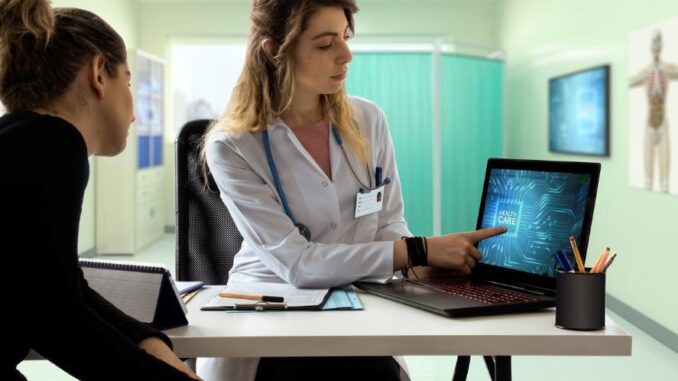
Bridging the gap between academic knowledge and real-world application is an essential part of the learning process in every educational setting. This is because students can’t learn everything about their chosen profession within the four walls of a lecture room, particularly when it comes to medical professions. Additional learning opportunities may come in the form of internships or clinical placements, depending on the course. These avenues provide students with practical experiences and insights into their chosen field to prepare them for successful careers.
Undertaking a clinical placement is a crucial step for those intending to become certified as family nurse practitioners. Such practical experiences provide you with an opportunity to apply your theoretical knowledge in real-life healthcare settings. During clinical placements, you have the chance to work alongside experienced healthcare professionals to gain hands-on skills and improve your clinical competence.
To be involved in patient care across all ages, you need to understand what it truly means to be a family nurse practitioner. At a reputable university, such as Walsh University, having the opportunity to learn from hands-on experience on a clinical placement is crucial for a student nurse. At Walsh University, the clinical placement is where you would acquire the skills needed to provide preventive care and treatments as well as assist physicians. Students can also learn how to prepare and administer treatments; screen and assess patients; and help with challenging tasks such as setting up an IV or catheter. What are some of the other learning opportunities offered by this exciting chance to gain practical experience?
Seven learning opportunities in clinical placements
Before you start your clinical placement, it is essential you understand what some of the learning opportunities are and how you can utilize them as a nursing student.
Prescribing and administering drugs
Nurses play a unique and complex role in the prescription and administration of medicine. This is due to the fact that they are usually the last to check for errors before administering the medication. To prevent mistakes and guarantee patient safety, nursing students participating in clinical placements are given instructions on how to administer drugs.
According to WebMD, you would be taught the rights of medication administration, which cover the essentials needed to prevent mistakes while prescribing drugs to patients.
- One right is the “right patient/individual”. You must be certain that the patient you’re administering a drug to is the right patient for the medication. Nurses confirm this by comparing the patient’s wristband to the name on the prescription and prove it by asking the patient to identify themselves. In circumstances where the patient is unable to do this themselves, it’s your responsibility to use appropriate alternate measures of identifying the patient.
- Another right is the “right medication”. You have to verify that the medication being given to the patient has the same name as the one prescribed. Alongside this, you would learn to specifically examine the medication’s indications, contraindications, expiration date, side effects and precautions.
- Another right is the “right dose”. This comes after validating the drug and the patient’s identity are both correct. You must ensure that the correct strength of medication is administered. This is often done by estimating the dose and confirming its accuracy with the pharmacy to ensure the patient follows the proper guidelines.
- Another right is the “right time”. You will learn to ensure that the medication is administered at the appropriate intervals to sustain or achieve the intended therapeutic effect. This is made possible by evaluating the medication’s duration of action and confirming when the last dose was administered before giving a new dose.
- Another right is the “right route”. You would learn to administer drugs through the various routes (oral, intravenous, topical, subcutaneous, intramuscular). You would also confirm which route used for the administration of the medication is appropriate and convenient for the patient.
All of these points help you understand what boxes to check before giving out medication to patients. They also increase your understanding of how to effectively issue medications without violating any policy guiding patient health and safety.
Learning diagnostics
Diagnostics are essentially tests performed to diagnose an illness or condition. Your time at a clinical placement will show you that you must always be accurate in diagnostic approaches to avoid misdiagnosing. This is particularly important since the adverse effect of a misdiagnosis could be the patient taking medication that affects their health rather than treats their illness.
Appropriate diagnostics are necessary to efficiently carry out treatment or successfully manage the right health condition. You will be trained to be able to perform these assessments accurately.
There are two main types of diagnostic tests in any healthcare setting: invasive and non-invasive. Invasive diagnostic tests involve puncturing the patient’s skin, for example, taking blood samples. Non-invasive tests don’t involve puncturing the skin. Good examples of non-invasive tests would be taking patient saliva or urine samples.
Diagnostic tests are intended for specific purposes, all of which aim to confirm a disease or condition. Therefore, you are required to be familiar with all the various types of tests. These tests also include CT scans which are used to create three dimensional images of the different parts of the body, including bones, tissues and organs. They are used to diagnose infections, or internal injuries following an accident.
Another type of test is a biopsy, which is used to diagnose some medical conditions. A colonoscopy, for example, uses a colonoscope inserted into the anus through the rectum to diagnose bowel cancer. An eye test is used to diagnose several forms of eye disorders. X-rays, another form of test in the field, use radiation to create an image of the inner parts of the body and are often used to detect bone abnormalities.
It is important to note that you can’t give a precise diagnosis if you don’t understand the symptoms of the patient. Alongside your classroom and theoretical knowledge, a clinical placement would give you a chance to learn more about diagnosing patients. Such an opportunity will expose you to salient tips which could help you make a scientific guess before giving patients a precise diagnosis.
Screening patients
Patient screening is crucial to identify and assess the various diseases that afflict patients. Family nurse practitioners use screening as a tool to analyze a patient’s health status. The general screening technique often entails gathering data on the patient’s medical history (and their family’s medical histories) as well as the patient’s age, gender and other relevant criteria to identify risk factors for specific diseases and ailments.
This form of patient assessment may include physical, cultural, psychosocial and safety assessments. You would be trained on how to perform such screening processes to ensure you are able to provide a high quality of patient care. Some of the common screening examinations carried out include:
- Physical examination. This is usually a head-to-toe assessment which includes measurements of vital signs like body temperature, heart rate and blood pressure; checking for any physical signs or symptoms associated with underlying diseases or conditions (such as bruises, scars and rashes); examining the patient’s breath and body odor; inspecting urine color; as well as a general evaluation of the patient’s health status.
- Checking on the patient’s history. This is done to compile data and details on the patient as well as their family’s past and present health conditions. You would learn how to enquire about the patient’s previous and present medical history, their lifestyle preferences, background, beliefs and habits. For instance, you may need to ask questions like “how long have you had chest pain?” or “which of your family members has a history of hypertension?” All these checks can help you understand exactly what the patient needs in terms of care.
- Psychosocial assessment. This addresses the emotional needs of the patient in relation to their health. You may be asked to check the concentration level of the patient to identify any hallucinations or reduced mental wellbeing, as well as how they respond to their feelings and emotions.
These, and other forms of screening examinations, are learned during clinical placements. You would also be taught how to collate the information gathered from these examinations to make decisions about the patient’s health and welfare. This practical experience can help strengthen your professional career.
Setting up a catheter
A urinary catheter is a long tube that is inserted into the body to drain and collect urine from the urinary bladder. Inserting a catheter is a routine technique that nurses must perform, especially with elderly or chronically ill patients. It may be used for diagnostics, medicine administration, assisting with urine outflow from the urinary bladder, or performing irrigation.
You would learn how to set up a catheter – if you don’t know it – through a clinical placement. You would also get to learn about the different types and sizes of catheters, and the complications associated with their use. While you may have encountered this during your days learning the theory of nursing, a clinical placement is one of the places where you would be shown how to set a catheter up effectively in practice.
Upholding patients’ rights
Although you must have learned about patients’ rights in theory, you would have the opportunity to put these rights into practice through clinical placements. You would learn how to care for patients while safeguarding their rights through several means, including:
- providing information on treatment through screening;
- treating patients equally and with respect and dignity irrespective of their status or health condition;
- providing swift, urgent attention and treatment in the case of emergency;
- maintaining the privacy of patients’ records;
- recognizing the patient’s right to refuse care, while recommending other appropriate measures to improve their health.
Experience in these areas would prepare you for the real world of a professional where you would make decisions and be responsible for the consequences as a certified nurse.
Participating in patient care
Clinical placements allow you to participate in various aspects of patient care. These could range from routine care to caring for those with complex medical conditions. This exposure broadens your understanding of healthcare and prepares you to handle a diverse range of challenges. It enables you to understand the patient as a whole, rather than focusing solely on their medical condition.
A clinical placement also helps you learn to consider the physical, emotional and social factors that have an impact on a patient’s wellbeing. This will help you develop a holistic approach to their health. For example, religious beliefs play a major role in some people’s reluctance to undertake therapy. You have to understand all these areas before carrying out any treatment plan for the patient.
Gaining insights into the practical world
Clinical nursing placements provide a platform where students, who have been confined within their classrooms, are able to integrate the theory with practice. They are also an opportunity to acquire essential skills, including interpersonal skills, empathy, critical thinking, and attention to detail. All these skills help you communicate effectively, think and act quickly, stay organized and ensure patients are cared for to the best of your abilities.
A clinical placement is also a chance to test your abilities in practice. It’s a chance to gauge your confidence and competence level to prepare yourself for life beyond nursing college.
Preparing for your career
Through clinical placements, you can prepare yourself for your career by practicing essential skills and building experience. Your clinical placement is a mirror of the real world and its requirements. That’s why you need to gain hands-on training, refine your clinical competence, and develop your critical thinking abilities. These will help you navigate a wide range of patient scenarios, work effectively in interdisciplinary teams, and communicate empathetically with patients and their families.
Clinical placements also allow you to understand how technology has helped develop and revolutionize healthcare. You get to learn about novel approaches to healthcare and how to leverage them in improving patient health. This exposure helps you in handling the challenges and complexities of healthcare and gain essential confidence and professional readiness.
Building a network
Aside from learning from real-life experiences, clinical placements also help students to build a useful network for their future. During clinical placements, students have an opportunity to interact with experienced nurses, physicians, healthcare administrators and other healthcare professionals. This networking can result in valuable mentorship opportunities and guidance, as students can seek advice on career options, specialization options and personal development.
Networking can also lead to potential job offers or recommendations, as healthcare facilities often prefer to hire individuals with whom they are familiar. This makes clinical placement students more attractive candidates. Students on clinical placements can create networks within their placement organization which gives them access to extra workshops, conferences, and seminars where they can enhance their knowledge and skills, which improves their professional development.
Conclusion
Clinical placements are invaluable learning opportunities, and although they can be challenging at times, throwing yourself into your work, making use of available resources and not being afraid to ask for help can ensure that your placement is an exciting time during your nursing training. Many students prefer clinical placement to academic term time precisely because it allows you to apply the medical care knowledge you have been studying so hard to learn, to the real world. The opportunities you receive on placement to demonstrate and consolidate your existing knowledge as well as to build upon it, are nearly endless. So above all, enjoy it!








